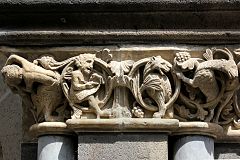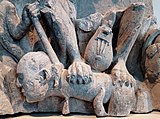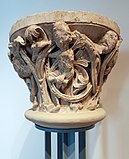Laacher Samson Master

The Laacher Samsonmeister is a collective or emergency name for an anonymous late Roman stonemason who was active in the Lower and Middle Rhine area between 1190 and 1220 . The so-called “Samson fragment” in Maria Laach Abbey in 1929 gave the impetus for research into the sculptor and led to the naming of the “master” by W. Bader.
Work history

Beyond the field of architectural ornamentation , the Samson master was primarily effective as a creator of large-scale architectural sculptures . The study by B. Kaelble in 1981, which is based in particular on the analysis of the working method and styles as well as on new finds, enabled the attributions and dates of individual work groups, which have fluctuated in previous research, to be reassessed and placed on a secure basis.
The chronological order of the works that can be attributed today is as follows:
- seated female donor figure from the tympanum of the southern side choir portal of the former Benedictine monastery church Brauweiler
- three relief fragments of a Last Judgment from the former rood screen of the Liebfrauenkirche in Andernach (today in the Rheinisches Landesmuseum Bonn )
- the Samson fragment, probably the rest of a lectern support from the former rood screen of the Benedictine Abbey of Maria Laach
- two animal fragments - an eagle and a bull - from the former choir stalls of the monastery church in Maria Laach (today also in the Rheinisches Landesmuseum Bonn)
- Frieze and capitals on the vestibule - the so-called paradise - of the Maria Laach abbey church
- two choir stalls in Bonn Minster
- a leaf capital of the St. Andreas Church in Cologne
- two figurative capitals in the Rheinisches Landesmuseum Bonn, one possible from the Brauweiler Abbey, the other possible from St. Gereon or St. Pantaleon in Cologne
- Portal rudiments on the Schwanenburg in Kleve .
The artistic tradition of the Rhine-Maas area and the outstanding role model of Nikolaus von Verdun shaped the style . In addition, suggestions from the then predominant artistic core areas were decisive: the northern French-early Gothic and the Byzantine areas ( St. Denis , Laon , Braine , Chartres , Paris ).
The Samson master also took motivic and iconographic suggestions from illuminating (Douai, Bibl. Municipale, Ms. 19).
In contrast to other sculptors, however, one cannot say that the Laacher Samson can be derived from the “statue column” of the French portals. There are clear differences with regard to the structure of the body and the treatment of clothing in relation to the body. The material lies on the body as a solid layer "and seems to merge into it indistinguishably in places ..." . “This procedure also means that the sculptures of the Samson master appear heavier overall than the French sculptures, which are slightly moved in their flowing robes” (B. Kaelble).
The Byzantine sources of the Samson master can be found in the traditional canon of proportions in the painter's book from Mount Athos.
No dates of life of the Samson master have been passed down. But if you take into account the style criteria and the data on the respective building history in Andernach, Brauweiler, Cologne and Maria Laach, then it can be assumed that the Samson master worked in Cologne around 1200 and 1208–1210. Between 1200 and 1210 he could have stayed in Maria Laach. The animal fragments in the Rheinisches Landesmuseum Bonn also belong to this period.
The Samson master was involved in all of the major Lower Rhine church buildings of the late 12th and early 13th century, which speaks for a special artistic talent. He has processed very different suggestions into independent, particularly expressive works and emerges as a leading personality in the late Romanesque architectural sculpture of the Rhineland.
literature
- H. Beenken: Romanesque sculpture in Germany, 11. u. 12th century 1924
- W. Bader: The sculptor of the Laacher Samson . In: Bonner Jahrbücher . Issue 133, 1929
- W. Bader and H. Lehner: Building history studies at Bonn Minster . In: Bonner Jahrbücher . Issue 136/137, 1932
- W. Bader: The Benedictine abbey Brauweiler . 1937
- Hermann Schnitzler: On late Staufer sculpture on the lower Middle Rhine . In: Pantheon . Volume 22, 1938
- Wolfgang Fritz Volbach: The angel from Lonnig. On the story of the Samson master . In: form and content. Festschrift for O. Schmitt . Stuttgart 1952
- K.-A. Wirth: Contributions to the problem of the "Samson master" . In: Journal for Art History . Volume 20, 1957
- G. Hojer: Two newly discovered evangelist symbols of the Samson master . (The Rheinisches Landesmuseum Bonn 2); 1967
- A. Schippers and Th. Bogler (arrangement): The Laacher Münster . 1967
- D. Cremer and O. Kettenberger: Samson. On the interpretation of a Laacher master . Wuerzburg 1969
- Reiner Haussherr: The sculpture of the early and high Middle Ages on the Rhine and Maas . (Rhine and Maas, catalog, volume 2, 1973)
- Richard Hamann-McLean: Byzantine and late antiquity in the workshop of Nicholas of Verdun . In: Kölner Domblatt . Volume 42, 1977
- B. Kaelble: Investigations into the large-figure sculpture of the Samson master . 1981 (Articles on the architectural and art monuments in the Rhineland, Volume 27)
- F. Broscheit: Figurative representations in the Romanesque architectural ornamentation of the Rhine-Maas area . Dissertation 1987
- Karen Staub, and Adam Stead (Eds.): The Samson Master and His Time. Romanesque sculpture in the Rhineland ; Exhibition catalog Museum Schnütgen Cologne. 2018
swell
- Lexicon of Art: Samsonmeister, p. 4. Digital Library Volume 43: Lexicon of Art, p. 29677 (cf. LdK Vol. 6, p. 371) (c) EA Seemann]
| personal data | |
|---|---|
| SURNAME | Laacher Samson Master |
| BRIEF DESCRIPTION | late Romanesque stonemason |
| DATE OF BIRTH | before 1190 |
| DATE OF DEATH | after 1220 |




